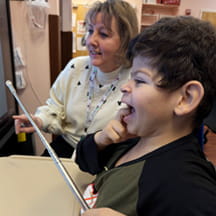Eliminating metaphorical “silos” is a common challenge for any organization with multiple departments. When Cincinnati Children's realized institutional silos limited access to school-related resources, hospital leaders created a solution with a different metaphorical slant.
“We wanted to essentially build a ‘front door’ to help our partner schools as well as our internal teams who work with the schools,” said Monica Mitchell, PhD, pediatric psychologist and senior director of community relations at Cincinnati Children’s.
Cincinnati Children's Center for School Services and Educational Research and its population health program collaborated to create a single point of entry to its extensive internal and external partnerships. This “front door” streamlined access to school-related services, including school-based health centers, psychiatric services, telehealth, and its pediatric accountable care organization.
There are three primary components to the front door:
- Simplified requests. Previously, requests for school-related services — such as having a hospital-affiliated speaker come to a school, assistance in analyzing data, or a patient service request — were essentially a “shot in the dark” for their school partners, according to Mitchell. Now, requests are directed to a simple form that is routed by the school services team to the proper department at the hospital.
- Data tracking. Because requests were traditionally siloed, there was no way to know how—or even if—they were fulfilled. Cincinnati Children’s now tracks each request, aiming for a 24- to 48-hour response time. The central repository for school requests also helps the hospital identify trends, informing proactive outreach efforts.
- Quality improvement. The consolidated approach allows for peer learning around school-related programs. In addition to regular meetings with school stakeholders, the school services team also convenes internally to share lessons learned.
Better access, better outcomes
These improvements had immediate effects among Cincinnati Children's behavioral health population:
- The single point of access enabled the hospital to increase psychiatric services in more than 60 schools across nine districts.
- Gleaning lessons from school officials and families, the school services team now targets interventions based on identified risk factors — including clinical severity and history of self-injury — while also providing a therapeutic environment that includes positive reinforcement and family support.
- Enhanced access has provided students alternatives to inpatient care, including partial hospitalization programs, intensive outpatient programming, case management, and emergency bridge sessions.
The result: a decrease in behavioral health readmissions among these patients from 46% to 39%.
“The way this happens is definitely not a magic wand or anything like that,” Mitchell said. “But to have readmissions 7% is a really big success story.”
Beyond traditional borders
Cincinnati Children’s serves more than 1,300 schools across Ohio, Indiana, and Kentucky, and supports students in all 50 states and internationally. A central access point is crucial to meeting the needs of this large population.
It’s also useful in coordinating large-scale events — notably, Cincinnati Children's mobile care center. The 38-foot vehicle is equipped with many of the resources available at the hospital, including two private exam rooms and medical, diagnostic, and laboratory testing capabilities. Through the mobile care center, Mitchell and her team have conducted vision and vaccine clinics at schools, as well as an annual back-to-school health fair at a school more than 60 miles from the hospital.
“It really is amazing how we're able to bring the services we have inside our hospital to a school or to the community,” Mitchell said. “When you partner with schools, you have the potential to do transformative work, and these are the things that we coordinate through this ‘front door’ point of access.”



